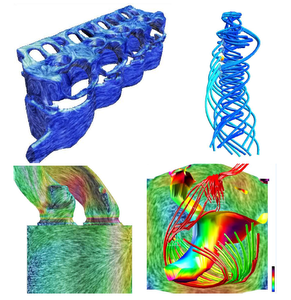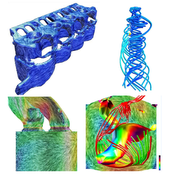Information
- Publication Type: PhD-Thesis
- Workgroup(s)/Project(s):
- Date: 2004
- Date (Start): July 2001
- Date (End): December 2004
- TU Wien Library:
- First Supervisor: Helwig Hauser
Abstract
This thesis presents research in the area of flow visualization. The theoretical framework is based on the notion that flow visualization methodology can be classified into four main areas: direct, geometric, texture-based, and feature-based flow visualization. Our work focuses on the direct, geometric, and texture-based categories, with special emphasis on texture-based approaches.After presenting the state-of-the-art, we discuss a technique for resampling of CFD simulation data. The resampling tool addresses both the perceptual problems resulting from a brute force hedgehog visualization and flow field coverage problems. These challenges are handled by giving the user control of the resolution of the resampling grid in object space and giving the user precise control of where to place the vector glyphs.
Afterward, we present a novel technique for visualization of unsteady flow on surfaces from computational fluid dynamics. The method generates dense representations of time-dependent vector fields with high spatio-temporal correlation. While the 3D vector fields are associated with arbitrary triangular surface meshes, the generation and advection of texture properties is confined to image space. Frame rates of up to 60 frames per second are realized by exploiting graphics card hardware. We apply this algorithm to unsteady flow on boundary surfaces of, large, complex meshes from computational fluid dynamics composed of more than 200,000 polygons, dynamic meshes with time-dependent geometry and topology, as well as medical data. We also apply texture-based flow visualization techniques to isosurfaces. The result is a combination of two well known scientific visualization techniques, namely iso-surfacing and texture-based flow visualization, into a useful hybrid approach.
Next we describe our collection of geometric flow visualization techniques including oriented streamlines, streamlets, a streamrunner tool, streamcomets, and a real-time animated streamline technique. We place special emphasis on necessary measures required in order for geometric techniques to be applicable to real-world data sets.
In order to demonstrate the use of all techniques, we apply our direct, geometric, and texture-based flow visualization techniques to investigate swirl and tumble motion, two flow patterns found commonly in computational fluid dynamics (CFD). Our work presents a visual analysis of these motions across three spatial domains: 2D slices, 2.5D surfaces, and 3D.
Additional Files and Images
Weblinks
No further information available.BibTeX
@phdthesis{Laramee-2004-thesis,
title = "Interactive 3D Flow Visualization Based on Textures and
Geometric Primitives",
author = "Robert S. Laramee",
year = "2004",
abstract = "This thesis presents research in the area of flow
visualization. The theoretical framework is based on the
notion that flow visualization methodology can be classified
into four main areas: direct, geometric, texture-based, and
feature-based flow visualization. Our work focuses on the
direct, geometric, and texture-based categories, with
special emphasis on texture-based approaches. After
presenting the state-of-the-art, we discuss a technique for
resampling of CFD simulation data. The resampling tool
addresses both the perceptual problems resulting from a
brute force hedgehog visualization and flow field coverage
problems. These challenges are handled by giving the user
control of the resolution of the resampling grid in object
space and giving the user precise control of where to place
the vector glyphs. Afterward, we present a novel technique
for visualization of unsteady flow on surfaces from
computational fluid dynamics. The method generates dense
representations of time-dependent vector fields with high
spatio-temporal correlation. While the 3D vector fields are
associated with arbitrary triangular surface meshes, the
generation and advection of texture properties is confined
to image space. Frame rates of up to 60 frames per second
are realized by exploiting graphics card hardware. We apply
this algorithm to unsteady flow on boundary surfaces of,
large, complex meshes from computational fluid dynamics
composed of more than 200,000 polygons, dynamic meshes with
time-dependent geometry and topology, as well as medical
data. We also apply texture-based flow visualization
techniques to isosurfaces. The result is a combination of
two well known scientific visualization techniques, namely
iso-surfacing and texture-based flow visualization, into a
useful hybrid approach. Next we describe our collection of
geometric flow visualization techniques including oriented
streamlines, streamlets, a streamrunner tool, streamcomets,
and a real-time animated streamline technique. We place
special emphasis on necessary measures required in order for
geometric techniques to be applicable to real-world data
sets. In order to demonstrate the use of all techniques, we
apply our direct, geometric, and texture-based flow
visualization techniques to investigate swirl and tumble
motion, two flow patterns found commonly in computational
fluid dynamics (CFD). Our work presents a visual analysis of
these motions across three spatial domains: 2D slices, 2.5D
surfaces, and 3D. ",
address = "Favoritenstrasse 9-11/E193-02, A-1040 Vienna, Austria",
school = "Institute of Computer Graphics and Algorithms, Vienna
University of Technology ",
URL = "https://www.cg.tuwien.ac.at/research/publications/2004/Laramee-2004-thesis/",
}


 pdf
pdf
